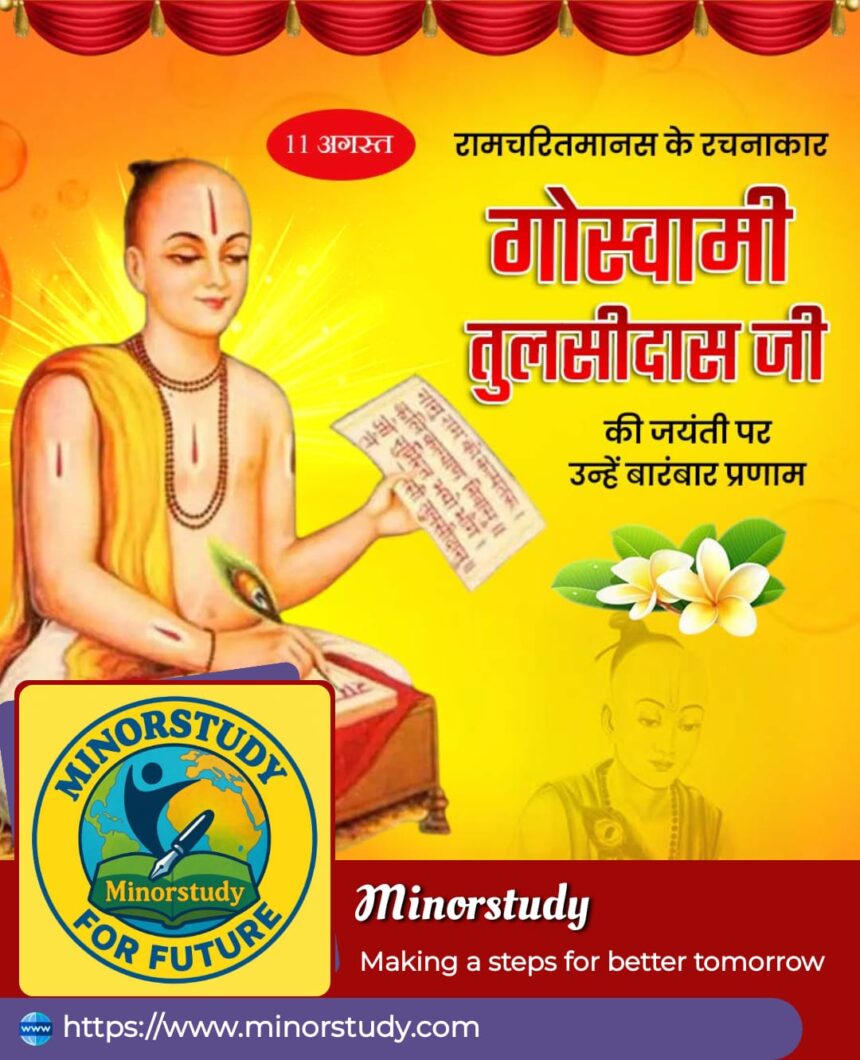Introduction
Goswami Tulsidas Ji is one of the most revered poets, saints, and philosophers in Indian history. Born in the 16th century, he is best known as the author of the Ramcharitmanas, an epic retelling of the Sanskrit Ramayana in Awadhi, making the divine story accessible to the common people. His verses are filled with devotion, morality, and profound wisdom, influencing Indian spiritual and cultural life for centuries.
- Introduction
- History of Goswami Tulsidas Ji
- Major Works of Goswami Tulsidas Ji
- Interesting Facts about Goswami Tulsidas Ji
- Timeline of Goswami Tulsidas Ji’s Life
- Significance of Goswami Tulsidas Ji
- Observance of Tulsidas Jayanti
- Important Points about Goswami Tulsidas Ji
- Wishing on Tulsidas Jayanti
- Importance in Our Life and Society
- Daily Life Impacts of His Teachings
- FAQs about Goswami Tulsidas Ji
- Conclusion
Tulsidas Ji’s life is an extraordinary tale of transformation—from a man deeply attached to worldly life to a saint whose devotion to Lord Rama became his identity. His works continue to guide millions toward a path of love, righteousness, and faith.
History of Goswami Tulsidas Ji
Tulsidas Ji was born in 1532 CE (Samvat 1589) in Rajapur, a small village in present-day Uttar Pradesh, India. There is some debate about the exact date and place of his birth, but most traditions agree on these details.
According to popular legends:
Tulsidas Ji was born with 32 teeth already in his mouth (hence his name “Tulsidas,” meaning one with extraordinary blessings).
His parents abandoned him shortly after birth due to unusual astrological predictions.
He was raised by a saint named Narharidas, who initiated him into the chanting of Lord Rama’s name.
In his early years, Tulsidas married Ratnavali, and this attachment to his wife was so strong that he couldn’t stay away from her for long. One rainy night, when she was at her parental home, he swam across the flooded Yamuna River to meet her. Ratnavali, shocked by his obsession, rebuked him with words that transformed his life:
“If you had even half this devotion for Lord Rama, your life would be truly blessed.”
From that moment, Tulsidas renounced worldly life and became a wandering saint, dedicating his existence to the worship of Lord Rama.
Major Works of Goswami Tulsidas Ji
Tulsidas Ji was a prolific writer and composed several works in Awadhi, Braj, and Sanskrit. Some of his most important works include:
Ramcharitmanas – His magnum opus, narrating the story of Lord Rama in a simple and devotional style.
Hanuman Chalisa – A 40-verse hymn praising Lord Hanuman, widely recited across India.
Vinaya Patrika – A heartfelt devotional prayer seeking Lord Rama’s mercy.
Dohavali – A collection of moral couplets.
Kavitavali – Poetic verses illustrating devotion and moral values.
Interesting Facts about Goswami Tulsidas Ji
He is believed to have met Lord Hanuman in person, who blessed him with divine vision of Lord Rama.
The famous Sankat Mochan Hanuman Temple in Varanasi is said to have been founded by him.
His Hanuman Chalisa is among the most translated and recited prayers in the world.
Tulsidas Ji is credited with making the story of Rama accessible to common people, breaking the language barrier from Sanskrit to local dialects.
It is said that once, Mughal Emperor Akbar summoned him, impressed by his influence on society.
Timeline of Goswami Tulsidas Ji’s Life
| Year (Approx.) | Event |
|---|---|
| 1532 CE | Birth in Rajapur, Uttar Pradesh |
| Childhood | Raised by saint Narharidas |
| Youth | Marriage to Ratnavali |
| Turning Point | Ratnavali’s advice inspires his spiritual journey |
| Mid-Life | Writes Ramcharitmanas in Varanasi |
| Later Years | Composes devotional works like Hanuman Chalisa |
| 1623 CE | Leaves his mortal body in Varanasi |
Significance of Goswami Tulsidas Ji
Goswami Tulsidas Ji holds immense significance for Indian literature, spirituality, and culture:
Religious Significance: His works strengthen Bhakti (devotion) and promote the ideals of Dharma, love, and service.
Cultural Impact: His writings have shaped festivals, folk songs, and performing arts like Ramlila.
Linguistic Contribution: He elevated Awadhi to a literary language.
Philosophical Depth: He combined the philosophy of Advaita Vedanta with the devotional fervor of Bhakti Yoga.
Observance of Tulsidas Jayanti
Tulsidas Jayanti is celebrated annually on Shravan Shukla Saptami (July–August). Devotees:
Read Ramcharitmanas and Hanuman Chalisa.
Offer flowers, lamps, and sweets to Lord Rama and Hanuman.
Participate in satsangs, bhajans, and kirtans.
Remember Tulsidas Ji’s contributions and recite his dohas (couplets) for moral guidance.
Important Points about Goswami Tulsidas Ji
A saint who made divine knowledge available to the masses.
His devotion was inclusive—welcoming people from all walks of life.
Strong advocate for ethical living and truthfulness.
Believed that chanting the name of God is the highest form of worship.
Wishing on Tulsidas Jayanti
“On Tulsidas Jayanti, may the wisdom of his words guide your path, and may Lord Rama’s blessings fill your life with peace, devotion, and happiness.”
Importance in Our Life and Society
Even today, Tulsidas Ji’s teachings resonate deeply:
In Personal Life: Encourages discipline, patience, and faith in God during challenges.
In Family Life: His verses promote unity, respect, and moral values.
In Society: Promotes harmony, compassion, and service to others.
Daily Life Impacts of His Teachings
Many people begin their day with Hanuman Chalisa, gaining strength and positivity.
Ramcharitmanas readings are still a household tradition in India.
His moral couplets are used in everyday conversations to give advice.
FAQs about Goswami Tulsidas Ji
Q1. When was Tulsidas Ji born?
He was born around 1532 CE in Rajapur, Uttar Pradesh.
Q2. What is Goswami Tulsidas Ji famous for?
For writing Ramcharitmanas and Hanuman Chalisa.
Q3. Did Tulsidas Ji meet Lord Hanuman?
Yes, according to legend, he met Lord Hanuman in Varanasi.
Q4. Why did Tulsidas Ji write in Awadhi instead of Sanskrit?
To make the story of Rama accessible to the common man.
Q5. When did Tulsidas Ji die?
He passed away in 1623 CE in Varanasi.
Conclusion
Goswami Tulsidas Ji’s life is a testament to the power of transformation through devotion. From a worldly man deeply in love with his wife to one of the greatest saints in Indian history, his journey inspires us to rise above attachments and dedicate ourselves to higher ideals. His works like Ramcharitmanas and Hanuman Chalisa are not just religious texts but treasures of wisdom, moral guidance, and cultural heritage.
In our modern, fast-paced world, where distractions are endless, Tulsidas Ji reminds us to anchor ourselves in devotion, truth, and compassion. By following his teachings, we can lead a balanced, fulfilling, and spiritually enriched life.








